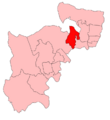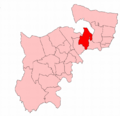Finchley (UK Parliament constituency) facts for kids
Quick facts for kids {{{Name}}}[[{{{Type}}} constituency]] |
|
|---|---|
| [[Image:{{{Map1}}}Constituency.svg|120px|]] [[Image:England{{{Map2}}}.svg|120px|]] |
|
| {{{Name}}} shown within [[{{{Entity}}}]], and {{{Entity}}} shown within England | |
| Created: | {{{Year}}} |
| MP: | {{{MP}}} |
| Party: | {{{Party}}} |
| Type: | House of Commons |
| County: | [[{{{County}}}]] |
| EP constituency: | [[{{{EP}}} (European Parliament constituency)|{{{EP}}}]] |
Finchley was an area in the United Kingdom that had its own special representative in the House of Commons. This representative is called a Member of Parliament (MP). The MP for Finchley was chosen using a system called "first-past-the-post," where the candidate with the most votes wins.
The most famous MP for Finchley was Margaret Thatcher. She was the Prime Minister of the UK from 1979 to 1990. Even though the borders of the Finchley area changed over time, she always won her elections there by a good number of votes during her time as Prime Minister.
The Finchley area stopped being a separate voting area in 1997. Its parts were then included in two new voting areas: Finchley and Golders Green and Chipping Barnet.
Contents
What was Finchley's area?
The borders of the Finchley voting area changed several times over the years. Here's how they looked:
- 1918–1945: It included the areas known as the Urban Districts of Finchley and Friern Barnet.
- 1945–1950: The area grew to include the Municipal Borough of Finchley, part of the Municipal Borough of Hornsey, and part of the Urban District of Friern Barnet.
- 1950–1974: The borders went back to being similar to 1918, including the Municipal Borough of Finchley and the Urban District of Friern Barnet.
- 1974–1997: The area was defined by specific local government areas called wards within the London Borough of Barnet. These were East Finchley, Finchley, Friern Barnet, St Paul's, and Woodhouse.
When it was first created in 1918, Finchley was part of Middlesex county. Before this, the town of Finchley was part of the Hornsey voting area. In 1934, the Finchley district became a Municipal Borough, which is a type of local government area.
In 1945, some changes were made to voting areas across the UK to make sure that areas with many voters were split up. This happened before bigger changes in 1950. Middlesex was one of the areas that saw these changes.
In 1950, Finchley was officially called a "borough constituency." This meant it was a voting area within a town or city, rather than a larger county area. Its borders mostly returned to what they were in 1918.
In 1965, the county that Finchley belonged to changed. It moved from Middlesex to Greater London, becoming part of the new London Borough of Barnet.
Who represented Finchley?
Many different people were elected as the Member of Parliament (MP) for Finchley. Here is a list of the MPs who represented Finchley:
| Year | Member | Party | ||
|---|---|---|---|---|
| 1918 | John Newman | Unionist | ||
| 1923 | Atholl Robertson | Liberal | ||
| 1924 | Edward Cadogan | Unionist | ||
| 1935 | John Crowder | Conservative | ||
| 1959 | Margaret Thatcher | |||
| 1992 | Hartley Booth | |||
| 1997 | constituency abolished | |||
How elections worked in Finchley
People in Finchley voted in general elections to choose their MP. These elections happened regularly, usually every few years. The person who won the most votes became the MP for Finchley.
One of the most important elections for Finchley was in 1959, when Margaret Thatcher was first elected as the MP. She won by a large number of votes.
| General election 1959: Finchley | |||||
|---|---|---|---|---|---|
| Party | Candidate | Votes | % | ±% | |
| Conservative | Margaret Thatcher | 29,697 | 53.2 | ―1.4 | |
| Labour | Eric Deakins | 13,437 | 24.1 | ―7.3 | |
| Liberal | Henry Ivan Spence | 12,701 | 22.7 | +8.7 | |
| Majority | 16,260 | 29.1 | +6.0 | ||
| Turnout | 55,835 | 80.8 | +2.5 | ||
| Conservative hold | Swing | +3.0 | |||
Margaret Thatcher continued to be the MP for Finchley through several more elections, even when she became Prime Minister in 1979. She always managed to win her seat comfortably.
The last general election for Finchley as a separate voting area was in 1992. After this, the area was split up into new constituencies.
| General election 1992: Finchley | |||||
|---|---|---|---|---|---|
| Party | Candidate | Votes | % | ±% | |
| Conservative | Hartley Booth | 21,039 | 51.2 | ―2.7 | |
| Labour | Ann Marjoram | 14,651 | 35.7 | +4.0 | |
| Liberal Democrats | Hilary Leighter | 4,568 | 11.1 | ―2.8 | |
| Green | Ashley Gunstock | 564 | 1.4 | New | |
| Monster Raving Loony | Sally Johnson | 130 | 0.3 | New | |
| Natural Law | James Macrae | 129 | 0.3 | New | |
| Majority | 6,388 | 15.5 | ―6.7 | ||
| Turnout | 41,081 | 77.6 | +8.2 | ||
| Conservative hold | Swing | ―3.3 | |||
Sources
- Boundaries of Parliamentary Constituencies 1885–1972, compiled and edited by F.W.S. Craig (Parliamentary Reference Publications 1972)
| Parliament of the United Kingdom (1801–present) | ||
|---|---|---|
| New constituency | UK Parliament constituency 1918–1997 |
Succeeded by Finchley and Golders Green (newly created seat) |
| Succeeded by Chipping Barnet (in part) |
||
| Preceded by Sidcup |
Constituency represented by the leader of the opposition 1975–1979 |
Succeeded by Cardiff South East |
| Preceded by Cardiff South East |
Constituency represented by the prime minister 1979–1990 |
Succeeded by Huntingdon |
Images for kids




